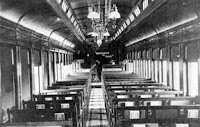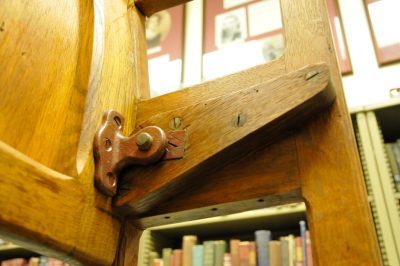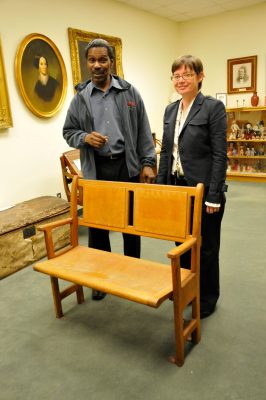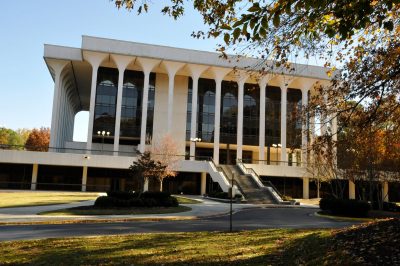
Messenger of Peace interior with pews, May 1898. Image courtesy of the Adair County (MO) Historical Society.
Chapel car 5 Messenger of Peace was built with a full complement of pews. Unfortunately changes in use and 113 years of history resulted in the loss of all the originals. But the Messenger of Peace had four “siblings” – they were other chapel cars built to the same plan by the Barney and Smith Car Company. And as fate would have it, a pew from Herald of Hope was donated to the American Baptist Historical Society (“ABHS”) and is held in their collection at Mercer University in Atlanta, GA. So after a recent effort to measure, photograph, and make cardboard templates, there is a “herald of hope” that Messenger of Peace may soon again have pews.
Herald of Hope was the chapel car built two years after Messenger of Peace, and in 1900 was also the last such wooden car constructed. It was called the “Young Men’s Car” because it was funded as a project of the young men of the Woodward Avenue Church in Detroit, MI. Even though early Twentieth Century Detroit was a very prosperous industrial center, fundraising to purchase an entire railroad car was a remarkable achievement. This stands in contrast to the Messenger of Peace, which was known as the “ladies’ car” because it was funded by subscriptions purchased by ladies from across the entire country.
Herald of Hope served the Baptist Publication Society and Home Mission Society for 31 years. In 1931 it was moved off the rail to continue as a church, but finished out its days as an office at a coal mine in West Virginia. Fortunately, its final days as a chapel car were attended by its last parson’s widow. Mrs. Newton gave away many of the car’s furnishings including two portable organs and at least one pew. Later, one of the organs and a pew were donated to the ABHS and are today held in their archives at Mercer University.

Hinge and seat support for chapel car pew. There are a few challenges in reverse engineering something that cannot be taken apart but these have been overcome.
Examining a 111-year-old pew so that construction plans can be created is a delicate operation. Gloves are worn to protect the object from the acidic affects of bare hands. It cannot be disassembled – this is so the object may continue to serve the needs of researchers – and this makes it challenging to discover the type of joinery and the true profile of hardware. Photography occurs with available light only. Pencils are used to sketch and take notes. Calipers, a measuring tape and protractor are carefully applied to the artifact to take measurements. Acid free card stock is carefully cut to make templates of the curves and shapes. Five pages of sketches and notes, 100 photographs and 11 cardstock templates are now available to support construction of replica pews.

American Baptist Historical Society Archivist Jan Ballard and Associate Archivist Clarence Brown Jr. pose with chapel car Herald of Hope pew held in their collection.
Perhaps it is a coincidence that the “young men’s car” would help the “ladies car.” Notwithstanding, the helpful staff at the ABHS allowed the pew to be examined, dimensioned and photographed so that replica pews can be created for the Messenger of Peace. Special thanks to Archivist Jan Ballard and Associate Archivist Clarence Brown Jr. for their assistance with the rehabilitation of chapel car 5 Messenger of Peace.



Spike, Very interesting. I've seen a lot of rolling stock but I've never seen a chapel car anywhere. A one of a kind project with lots of attention to detail… Take Care, Big Daddy Dave